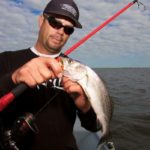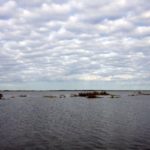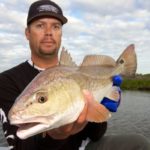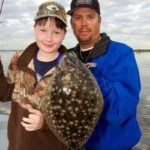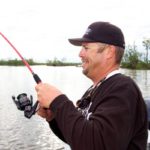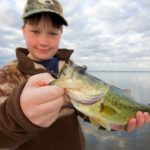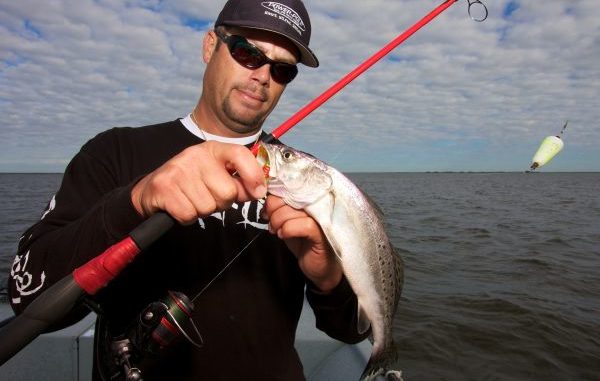
The Louisiana coastal marsh is always changing, but there’s one constant: The Pen out of Lafitte is a fishing oasis for reds, bass and speckled trout.
Change is inevitable in coastal marsh.
The tide gives when it rises and takes away when it falls.
Land piles up in some places while washing away in others.
Fish that you couldn’t stop from biting one day cease to exist the next.
Nowhere is this change more evident than in The Pen. One of the most-famous fishing holes in all of Southeast Louisiana, this Lafitte hotspot once wasn’t even a lake.
Capt. Donovan Hinton with Lagniappe Fishing Charters (504-382-4487) out of Lafitte told me that the approximately 4,000-acre lake was once a prime piece of agricultural land.
“I would have to talk to some of these old timers to be sure, but I think it used to be a rice field,” Hinton said. “At some point, the levees surrounding the plantation broke, and the entire area was flooded so quickly that equipment was left right where it was in the fields.”
Since then, The Pen has remained a popular fishery even if its star has risen and fallen as frequently as the tide that influences it on a daily basis.
“The tide isn’t the only thing that affects The Pen,” Hinton said. “There are lots of things going on here: hurricanes, storm surges, diversion canals. They have all impacted The Pen for better or worse.”
Hurricane Isaac was the most-recent agent of change.
Flotant dots the watery landscape of the southeast corner of The Pen, where perhaps a quarter mile of shoreline broke off from what used to be a defined, straight line.
“Going into last January and February, I personally caught a lot of limits of redfish there during the evenings,” Hinton said. “Some days they bit spoons, and some days we had to have shrimp.
“But for the most part, we could always catch fish in there.”
Will the change in the terrain make much of a difference this year?
According to Hinton, probably not. He expects fishing to remain good in this corner of The Pen, and in time, he believes, the tide is going to move the flotants out of the way.
“The lasting effects, for as long as something lasts in the marsh, will be that corner of The Pen will now be busted up where it used to be a straight line, and it will be shallower,” Hinton suggested.
Before Isaac, Tropical Storm Lee tore up The Pen in a different way.
Before Lee hit, Hinton said he could not run his boat from one corner of The Pen to the other without his outboard overheating from having to run through all the grass. This was when Hinton used to pull redfish out by jigging spinnerbaits in the holes.
“Lee took care of the grass by wiping it out back then,” Hinton said, “and we didn’t get much grass growing this past summer. For grass to be there in January, it has to grow in May and June.
“Even if it does sprout and grow then, a salty storm surge and storm winds will beat it up and kill everything.”
Before Lee or Isaac, there were Mississippi River diversions.
At first, many locals in Lafitte felt the diversion canals that siphoned fresh Mississippi River water through Lafitte were going to ruin the fishing, but that did not turn out to be the case.
“It may not have ruined it, but it did change it,” Hinton said. “I think if anything the diversion canals have increased the amount of fish here.
“That fresh water does have a lot of nutrients that bring life to The Pen and creates more to attract and hold these fish — grass, baitfish, whatever.”
Hinton does not feel that Davis Pond affects The Pen as much as it does Lake Salvador and Bayou Rigolets. Rather, he believes Ollie Canal running from the pumping station at Jesuit Bend, which has been running for years, has more influence.
“You can tell because we get muddy water running through all those canals and Blue Point,” he noted. “You got that siphon water coming out — that fresh water — and the bass and reds appear to adapt to that water. Back in those canals is some exceptional fishing in January and February.”
And the last little bit of change taking place in The Pen is the dredging in the south end. For an area about a half mile long north and south by a quarter mile wide east and west, the bottom has been dredged down to 25 feet.
“They pumped it south into some of the marsh lands there and built a big retainer wall,” Hinton said. “But we’ve run over it here lately with the depth finder, and it’s already between 12 and 16 feet. It’s already silted in that much.”
I approached Hinton with the idea of fishing The Pen because I hadn’t heard too much about it lately. I told him that all I could remember reading about The Pen was how good the trout fishing was during the winter.
“It’s been a long time since I’ve heard anything about the winter trout fishing in The Pen,” I texted him. “Either y’all are doing a good job keeping it quiet, or something’s up.”
Apparently, as many changes as The Pen has endured over the years, perhaps the one thing that hasn’t changed is how good the fishing is at this flooded farm.
Sure, there have been some swings from trout to bass, and the redfish bite better than anything else some days, but if a recent trip with Hinton was any indicator, anglers fishing The Pen can reasonably expect to catch just about anything that swims in the water.
My son Matthew and I met up with Hinton and his nephew Landon Gordon at Joe’s Landing with the idea of seeing firsthand how the bite in The Pen had changed from limits of wintertime speckled trout to stringers of bass and coolers full of redfish.
We idled under the Goose Bayou Bridge beside Cochiara’s and headed straight for Blue Point canal, where we immediately tried to entice some redfish with shrimp under popping corks.
Boats from a local bass tournament became more than we wanted to contend with, so Hinton ran us back to the mouth of the canal at the northeast corner of The Pen. Within a matter of minutes, we saw firsthand that the action was as reliable as ever.
Off of two nondescript points, my son and Hinton’s nephew landed largemouth bass, flounder, redfish and channel cats. Every one of them bit the shrimp, and we stayed on the redfish for a while before eventually deciding to head to the south side by Bayou DuPont.
We fished around the flotant a little bit to no avail, and then moved out to open water to try for some speckled trout.
Hinton rigged some green sparkle beetles under popping corks, and we simply started fan casting around his boat.
I wouldn’t call it every cast, but we put several keeper trout in the boat over the next hour or so. Trying to figure out how he knew where to fish, I asked Hinton how somebody like myself could find trout out in the middle of The Pen with no obvious landmarks around.
“If you look at a geophysical map of The Pen — those blue aerial maps — there is a difference in color where whatever tide influence runs from Bayou DuPont,” he explained. “A lot of water drains through that marsh, so whatever that current line shows on that map, I personally try to get where I think that is and try to fish that.”
Hinton went on to elaborate that this is the same area that has been dredged because the hole is in the current line.
His best advice to find trout is to center yourself east and west about a quarter to a half mile north of the south shoreline. If you get a couple bites, drop an anchor and fish it until it slacks off. When it does, look around for any signs of bait breaking the water and move to it.
“When you get on them this time of year, when you catch one, you’ll catch 10,” Hinton said as we stored our rods and packed up for the short ride back to Joe’s. “When you catch 10, you may catch 20.
“And don’t be afraid to change baits. If the green isn’t working, switch to black. If black doesn’t work, tie on whatever your daddy tied on your line when you were a kid and throw it in there.”
That was when I realized that as much as The Pen has changed over the years, much about it has remained the same. And some things have come full circle.
Take this recent text from Hinton for example.
“Fifty trout yesterday and 100 today in The Pen,” he texted. “Twenty-one boats in there, and all catching.”
The more things change, the more they remain the same.
Change is inevitable in the coastal marsh, but so is catching fish in The Pen.
